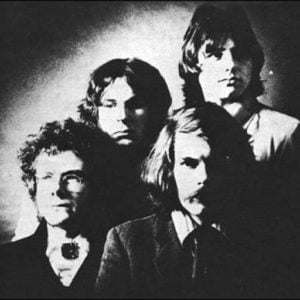Come join us now, and enjoy playing your beloved music and browse through great scores of every level and styles!
Can’t find the songbook you’re looking for? Please, email us at: sheetmusiclibrarypdf@gmail.com We’d like to help you!
King Crimson – The Court Of The Crimson King (Piano solo, sheet music)

King Crimson, pioneers of progressive rock
It is unquestionable and indisputable that King Crimson has been one of the most influential bands, and the pioneers of Progressive Rock of all time. The band of the late 1960s and early 1970s helped spread this genre, and other bands followed in their footsteps.
Please, subscribe to our Library.
If you are already a subscriber, please, check our NEW SCORES’ page every month for new sheet music. THANK YOU!
Like many other bands, King Crimson has been evolving throughout history, although there has always been a common element in all their works, the figure of the charismatic guitarist and leader of the band Robert Fripp (although he has never considered himself as such). ).
We will embark along the following lines in the history of this fascinating band that marked a before and after in the history of Rock. Join us on this tour to enjoy one of the most representative progressive rock bands.
The Progressive Rock
We already told you at the beginning of this article that the band emerged in the late 60s and early 70s. You know, that crazy time of hippies and LSD, so it is not surprising that the name of the band comes from an acid that at that time was frequently consumed in England, where the band comes from.
King Crimson’s first work came out in 1968, an album titled The Cheerful Insanity of Giles, Giles & Fripp, which roughly translates to ‘Giles’ Cheerful Insanity.’ In this work, the band shows us its great ability to mix sounds that include Pop, Folk, Rock, Jazz and Psychedelia.
But King Crimson’s Progressive Rock appears for the first time in what is considered to be the band’s first work, entitled In The Court of the Crimson King.
Here begins the meteoric rise of the band with its particular and revolutionary sound. On this album we find songs that go through different sounds, such as Epitaph, Moon Child, or I Talk To The Wind among others.
King Crimson and his popularity
King Crimson began their career to the top here, although the same musicians were not always in the band (up to 29 people, plus the 7 members of the present band). Of course, the one who has always, always been there has been Robert Fripp, the amazing guitarist.
The fact is that King Crimson had begun his meteoric rise to fame, especially after having played as the opening act for the Rolling Stones. Maybe that’s why the band’s debut album was such a hit, and, of course, they embarked on a super tour, and this one was a super tour, because there were so many concerts that there seemed to be no end. In fact, this was the main cause of the conflicts and tensions that existed in the band.
Well into the 70s, King Crimson released his new work In The Wake Of Poseidon, very much in line with the previous one, and which was also a great success. The creativity of the band was such that that same year they also released Lizard, in which the band shows more and more daring in their sound.
In 1972 the first live album, Earthbound, arrived. Yes, folks, one album per year, and that the line-up was literally left with four cats: the ever-present Fripp, Ian Wallace, Mel Collins and Boz Burrel. So, no more.
And since we’re going to record by year, in ’73 King Crimson released what is considered by many critics and fans as one of the band’s masterpieces, Lark’s Tongues in Aspic. An album in the purest King Crimson style, where we find a wide variety of sounds and themes.
Before the new decade began, King Crimson released three more works (two in ’74, which were Red and Starless and Bible Black, and in ’75, USA). It is in these last works published by the band where we can really appreciate that progressive rock and that daring that we were talking about, with sounds that go from Improvisation to Jazz, although always keeping that Rock essence.
King Crimson – Starless
King Crimson in the 80s and 90s
The 80s began with an emergence of bands that followed in the footsteps of King Crimson, although with songs of shorter minutes and more accessible to all audiences. Some would call this ‘the commercialization of the King Crimson sound’ or something like that, but let’s see what happened in the band during those decades of the 80’s and 90’s.
There were many who, with the emergence of new bands, thought that perhaps King Crimson had lowered his guard a bit, but no. Here they were again to prove their unique sound, and during the first four years of the ’80s, the band released a trilogy containing the albums Three of a Perfect Pair, Discipline and Beat.
Some time later, King Crimson decided to take a break, but they returned to the scene in ’94 with what promised to be an appetizer of their next work, Vrooom, a mini LP. Indeed, a year later they publish THRAK, in which we again see an evolution in the band’s sound, because in this work we find sounds very focused on Industrial Rock.
King Crimson and the new millennium
After the release of these last works, King Crimson returns to silence again until the year 2000, when they surprise everyone with a new work, The Construkction of Light, and as happened with their previous work, here we are to some King Crimson with airs more focused towards Rock Garage.
The last studio album released by the band was The Power to Belive in 2003. An album in which King Crimson shows once again that they have not stuck to one sound, and that they will always dare to try new ones, for That is why we find here sonorities very close to Industrial Metal.

The surprise came a year later, Fripp announces the dissolution of King Crimson. And so far so good. But, of course, in 2011 the fans of the band get confused because an album is released, Scarcity of Miracles, by a band called The Crimson Project… Mmmmm.
Anyway, King Crimson disappears or «digimusicoevolutes» towards a new band called The Crimson Project, a return of the band, but not new sound material, although they did publish numerous compilations, specials, etc.
As you have been able to verify throughout this article, King Crimson is a band that we could already put various adjectives such as ‘mythical’ or ‘legends’, they have given us a lot and very good sound material to enjoy, as well as being great influences for others generations of musicians, and, of course, worldwide fans.
King Crimson officialYouTube channel.
Best Sheet Music download from our Library.
Browse in the Library:
Or browse in the categories menus & download the Library Catalog PDF:
